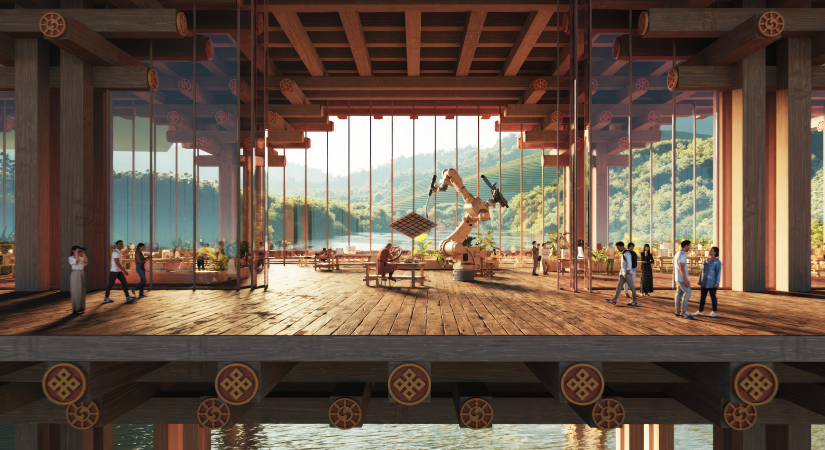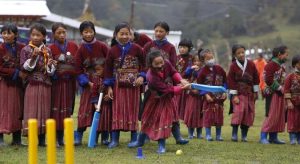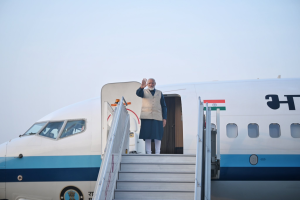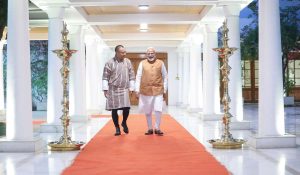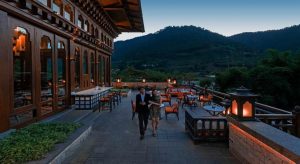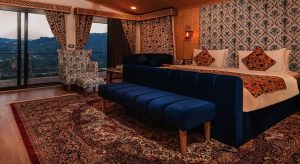I would say it’s extremely authentic so there’s nothing here that’s contrived for tourists. It’s really real. It’s very unusual now to go to places where you get this authenticity all the time…says Carissa Nimah, Chief Marketing Officer of Bhutan
Bhutan’s King Jigme Khesar Namgyel Wangchuck has a new vision for the country, to make it an economic hub for South Asia, pointing out that small countries like Bhutan are not trapped by legacy and can innovate swiftly to implement plans that other countries might hesitate to pursue.
Gelephu Mindfulness City Special Administrative Region (SAR) in the South of the Kingdom is set to become a leading hub through investments in green energy, physical and digital connectivity infrastructure and education. Mindfulness City is unique for being founded on Bhutanese values and the Gross National Happiness philosophy, prioritising not only economic development but personal well-being for every resident.
Bhutan is already known worldwide for being a haven of pristine natural beauty, spirituality and unique cultural traditions. The SAR is the world’s ‘Modern Buddhist Lifestyle Destination’ for spirituality, wellness and rejuvenation. Gelephu Mindfulness City is also the gateway for tourists to the rest of Bhutan, nestled between two nature reserves – the Phibsoo Wildlife Sanctuary and Royal Manas National Park – as well as connected to Thimphu via Paro airport.
Nestled between mountains, forests, and rivers, Bhutan stands as one of the last biodiversity hotspots in the world, with 70 percent of the country covered in forest. The Mindfulness City will cover an area of over 1,000 sq. km, or 250,000 acres. This is around 2.5 percent of the total surface area of the country.
Bjarke Ingels Group (BIG) shared its master plan for Mindfulness City. Proposing a series of bridges as new landmarks tailored to each of the nine Gross National Happiness domains, agricultural preservation, mobility connections, public spaces and low- to mid-rise development in the south of Bhutan.
The master plan aims to amplify the country’s abundant biodiversity by emerging as a vibrant tapestry of interconnected ecosystems forming eleven lively neighbourhoods shaped by the flow of the 35 rivers and streams that run through the site. The resulting ribbonlike neighbourhoods resemble paddy fields, forming urban terraces that cascade down from the hills to the valley. The city increases in density from the rural and recreational highlands to the urban and dense lowlands.
Each neighbourhood is designed based on the principles of the Mandala: defined by a series of repeating typologies organised symmetrically around a central public space, a gradual transition in density is created, from small buildings dispersed in the landscape in the north to larger footprints within an urban environment in the south.
To protect existing and future development against flooding in the monsoon season, paddy fields will be established along the site’s rivers and tributaries, running from north to south. These will further function as biodiversity corridors for local flora and fauna, leaving the migratory routes of elephants and other wildlife undisturbed.
We caught up with Carissa Nimah, Chief Marketing Officer of Bhutan to get more details.
Read Excerpts.
With the new SAR, do you expect a lot of Bhutanese people from surrounding areas to come and work here?
Nimah: Yes, definitely and I think the city will have a lot of knock-on impacts. There will be a lot of improvements in infrastructure and connectivity. There’s a big international airport that’s been planned and in fact, that’s going to be the first piece of the puzzle because when it’s ready in two years, we expect a flurry of activities. We expect the rest of the city to be completed anywhere from five years onwards.
The region will be inspired by the culture of Bhutan and its respect and compassion, the Mindfulness City’s vision will be to enhance ecological systems, while there will be urban development which will connect people and ideas with the flora and fauna. It is set to become a global example of creating a sustainable space for all.
What do you feel is the most magnetic and enchanting part of Bhutan?
Nimah: I would say it’s extremely authentic so there’s nothing here that’s contrived for tourists. It’s really real. It’s very unusual now to go to places where you get this authenticity all the time. For instance, last weekend was the biggest Paro festival, the biggest festival of the year and that’s not for tourists it’s for Bhutanese people. The word “magnetic” is important, because the energy in this country is really special. It’s a very spiritual destination and one respects the fact that it’s such a spiritual destination. You can hear everyone chanting, you see the flags and you see people turning the prayer wheels, there are more than 2000 temples and all these old structures like fortresses around the country.
You’re in the mountains, you’re at an altitude and the mountains are very imposing and I just feel that that creates a very special energy and it’s a great chance for people to come and learn but just to be here and reflect on yourself, and on your life. I think that’s special, you can’t find that many places like that on Earth. It’s like a spiritual pilgrimage that’s quite transformational for people.
What are the travel trends that you forecast for the region?
Nimah: This year is 50 years of tourism, as Bhutan only opened for international guests in 1974 this year, it’s important for Bhutan, which is a country still on its tourism journey. Tourism numbers haven’t quite recovered since before the pandemic but they are certainly on the right track, and Bhutan’s tourism strategy has now changed quite a lot. It’s now looking for higher-value guests. I would say higher profile, higher value guests don’t mean that everyone who comes has to be wealthy, but that’s not the point, we just want to attract people who want to be here.
We would love to achieve a target of 300,000 tourists which in terms of comparison to India is very low but for us in Bhutan that’s quite a lot. We’re trying to kind of facilitate new experiences and improve the entire guest journey to hit that number and also just promote a bit more to the world, both on a B2B level and B2C. There is very little awareness about what Bhutan has to offer, experiences, and itineraries, beyond the temples or Tiger’s Nest.
It’s I’d say it is very traditional and very authentic, but Bhutan is also trying to modernise in a way that’s very in line with its values. Modernise carefully I would say and it’s a really interesting time to promote Bhutan. It’s ready for growth but at the same time it doesn’t want to just do it willy-nilly, it wants to grow deliberately, carefully which I think is quite innovative for tourism boards, as most government tourism boards just focus on numbers and run the risk of losing culture, ruining your environment and that’s the real reason that people go there in the first place.
What are your tourism insights from India?
Nimah: We have seen a lot of Inbound tourism from America and other regions of the world which are expected to grow with the new airport. We are also focused on the Indian market. For foreigners, our Sustainable Development Fee is USD 100 per person, while for Indian nationals it is Rupees 1200 per person, per night. That just means that we attract the type of tourist who wants to be in Bhutan and explore the region. It’s not you just passing time for a weekend, but it’s a different type of tourist, I would say.
What are some of the guest experiences that have been curated?
Nimah: Still very much progress, but some of the new experiences include the Trans Bhutan Trail which is kind of repurposed the old human highway that spans from across the country earlier, it could take somewhere between 35 to 40 days, and before roads and cars that’s how people moved around.
In addition to that, we now allow Golden Mahseer fishing, catch and release, which is very elusive and found in the Himalayas. There’s also fly fishing, we just introduced a new astronomy experience because of the dark skies. You can learn about the history of time like how people navigated the skies and some of the historical things in Bhutan.
There are also river rafting and night rafting experiences that have been introduced, and there’s more to come. We’re also encouraging the private sector to come up with new experiences, some of which are just in the process of getting approvals.
What do you feel about the hospitality options and luxury in Bhutan?
Nimah: Bhutan has got a lot of really nice hotels, we have 10 five-star luxury brands here, which is quite a lot for a small country. We have Aman as the first hotel company to invest in 5 locations across its central and western valleys. Amankora has been a part of this legendary Buddhist Kingdom for almost 20 years. In addition, we have Six Senses, &Beyond, Le Meridien and a host of independent brands. We’ve got a lot of four and three-stars and what we see is that homestays are becoming increasingly popular. Guests want to experience a real mix, they want the comfort and the luxury of the 4 to 5-star but they also want the authentic experience of the three-star or family-run hotel, Bhutan offers both. I think that’s a real trend, maybe it’s just got something to do with authentic travel and people are chasing the experience along with luxury.
In the end, we would like to believe we have complete confidence in the success of the SAR undertaking, stating that Bhutan is blessed with an incredible opportunity to build its legacy via the Gelephu Mindfulness City.
ALSO READ-A Spiritual Journey through 108 Sacred Sites of Bhutan
